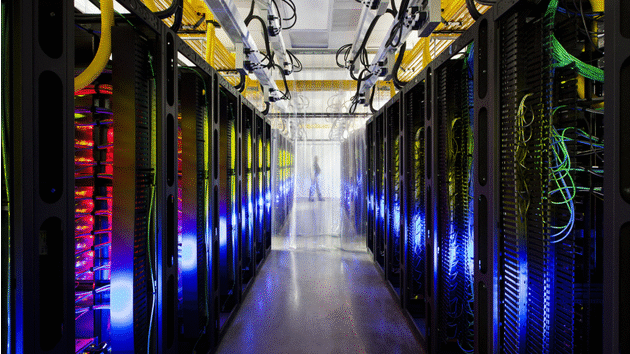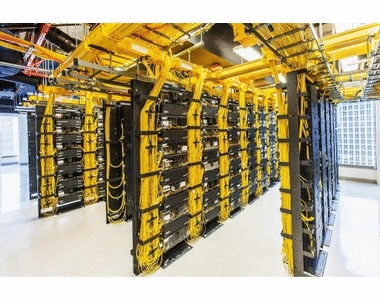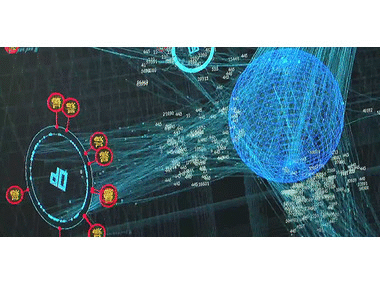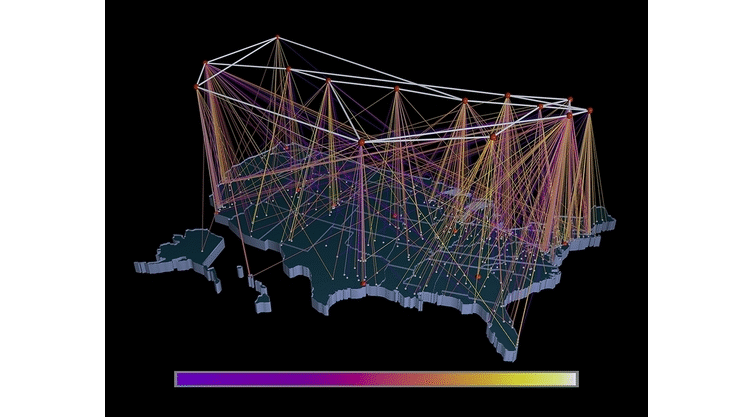Ken Ehrlich
A network is a break is a fissure a metaphor an analogy a misunderstood sign a desperate attempt a domain a reminder a sense of touch a feeling. A network is a broom closet a despairing glance a fondling a Gesamtkunstwerk a torrent a bitstream a bit bot bite a burger. A network is a stream a service a cum shot a chat room an anti-social network a dream or a dream team a sports network an algorithm a scream a syndrome a symptom. A network is my your our synonym an agent a provocateur a discourse a pet a cat video a system of surveillance a cavalier attitude an informant. A network is a network is a network is a network…

In a short text titled Network Pessimism, Alex Galloway takes aim at network fundamentalism. If the network has become so ubiquitous that Bruno Latour refers to ontology itself as a network and Donald Rumsfeld calls the battlefield a network, how to begin thinking critically about first, the idea that everything can be described as a network and that the proper response to an overabundance of networks calls for more networks. Rather than describe more and more contemporary phenomena as having network-like features or call for the creation of networks of resistance to combat the totality of certain networks, we might take seriously Galloway’s question in this text which asks quite simply: what is the political fate of networks?[1] And here I will propose that the political fate of networks is bound up with certain questions of geography. Not a version of static geography that is exclusively tied to a specific physical place, delimited by a prescribed understanding of location as presence, but rather geography as related to the territorial, the spaces always overly mapped and consistently misapprehended, and including all those as yet unmapped and all together unknowable. A thinking geography that highlights the particularity of spatial dynamics, but acknowledges and accounts for the here there everywhere of the mediated present. The memories that create the present. The obliterated past that is still caught up in an antagonistic contest of images.
One model for thinking about the political fate of networks might be the notion of cognitive mapping, which seems to be undergoing a productive reconsideration of Jameson’s notion in terms of contemporary efforts to think contemporary capitalism. To think about the political fate of networks, we need a picture that accounts for the complexity of networks but does not reproduce the uncritical euphoria of that concept with no grounding. A particularly lucid example of this methodology is Alberto Toscano and Jeff Kincle’s recent book, Cartographies of the Absolute, which attempts to look towards the efforts among artists to create means of understanding and navigating the complex worlds of the present.
“Cartographies of the absolute is a willfully paradoxical expression, but one that directs us towards the way in which picturing our social and economic world is a predicament at once technical and, so to speak, philosophical. Capitalism, after all, is a religion of everyday life, an actually-existing metaphysics.”[2]
The interconnected complexities of the global systems of finance, state power, and social control elude simple description and any map is not only partial but itself an ideological layer that imposes shapes and contours onto the sites of description.

A network is a question… a deluded proposition, an assemblage, a nurturing, a shiver.
A sequence of thoughts that might cohere into a series of questions.
How to draw – or trace – some connections between the revelations of mass surveillance made infamous by the leaks of Edward Snowden and the complex data and network infrastructure that lies – barely visible – just beyond the surface of the city of Los Angeles. There is no curtain to peek behind nor a pre-existing map to be puzzled together. The networks that link mass surveillance and the actual technical matter that houses the structures of the digital telecommunications systems is not an abstract picture, as seductive as that image might be. Not fragments nor itself a network, the connections between our surveilled digital communications and an evolving and expanding very not virtual technical infrastructure is material if not entirely classifiable.
The impulse to create a picture or an image – whether visual, textual or something else – persists. This tangled web of servers, ISP’s, Packets, switches, Fiber Optic Cable, Pulses of content in the form of surges of light, bundles of energy are not only interruptions.
Damage and damage control.
This is a story – half dreamed, always a partial fantasy – of an attempt to somehow picture the guts of the internet as particular to this place. Rooted. Located. Sited. And absent, evacuated, dispersed.
Los Angeles already appears with a peculiar relationship to visibility and invisibility. In the blinding sunshine, I can’t see what happens in the shadows. You know… sunshine and noir. Behind the lawns, immigrant labor, and water wars. Just past the surface of the big screen, an army of workers, carrying sandbags and apple boxes to support the lighting department. Some human hands pushing the dolly, setting up the track. Past the ultra shine mirror finish on the hoods of the endless stream of cars are oil stained garages and the soggy feet of the teams improvising car wash choreographies. Inside the homes on quiet streets the nannies and housekeepers, the carefully prepared lunches lovingly presented and the freshly scrubbed tiles. In so many cafes sprinkled across the city, twitching bodies sitting alone at tables staring into, onto, past small screens. And for some, a network is a form of unwaged social labor… That excruciating, often humiliating self imposed labor of identity preservation persists.
What is behind the keyboard and the router? What switches and signification lie past the wireless password and reflective screens? What does the network look like between appearance and presence? Where are the principal network sites? A network is not the lifeline of the city, but the enduring myth that embodies both stability and disorder.
A paradox. Only with an algorithmic system, with the aid of a digital imaging system, can an image of the network be produced. The network is the gateway drug to data. To understand the network, we need the data. To compile the data, we use the network. The data and the network merge in a heterogeneous militarized geography.
“The rationalist fantasy that enough data can be collected with the “right” methodology to provide an objective and disinterested picture of reality is an old and familiar one: positivism. This is the understanding that the social world can be known and explained from a value-neutral, transcendent view from nowhere in particular. … Emile Durkheim… believed it could function as a “social physics” capable of outlining “social facts” akin to the measurable facts that could be recorded about the physical properties of objects. It’s an arrogant view, in retrospect — one that aims for a grand, general theory that can explain social life…. the advent of Big Data has resurrected the fantasy of a social physics, promising a new data-driven technique for ratifying social facts with sheer algorithmic processing power.
Positivism’s intensity has waxed and waned over time, but it never entirely dies out, because its rewards are too seductive. The fantasy of a simple truth that can transcend the divisions that otherwise fragment a society riven by power and competing agendas is too powerful, and too profitable. To be able to assert convincingly that you have modeled the social world accurately is to know how to sell anything from a political position, a product, to one’s own authority. Big Data sells itself as a knowledge that equals power. But in fact, it relies on pre-existing power to equate data with knowledge.
The assumption is that there is more data today and there will necessarily be even more tomorrow, an expansion that will bring us ever closer to the inevitable “pure” data totality: the entirety of our everyday actions captured in data form, lending themselves to the project of a total causal explanation for everything….. This long-held positivist fantasy — the complete account of the universe that is always just around the corner — thereby establishes a moral mandate for ever more intrusive data collection.”[3]

A visit to One Wilshire – a symmetrical modernist cube of a building in downtown L.A. – is mostly a series of barriers, enclosures, the establishing of boundaries, of security protocol, background checks, forms filled out, signature lines. This building houses what is purported to be one of the most significant west coast sites of data centers, colocation, and peering. Or as the company who owns the building puts it:
Our cloud-enabled L.A. platform boasts one of the most-developed customer ecosystems in the world. Our customer community features more than 375 customers, including domestic and international carriers, media and entertainment firms, cloud computing providers, social networking sites, gaming companies and enterprise customers, deployed in more than 591,000 square feet of enterprise-class data center space.
A request for a visit. A response:
Thank you for your interest in touring CoreSite’s LA facilities. Unfortunately, our security policy does not allow us to provide tours unless you are engaged in an on-going discussion regarding deployment within our facilities.
A network is a mark, a sign, an imposition. A registry. A distortion. Noise.
Kazys Varnelis describes the complex array of spray painted signs and symbols on the pavement outside, on the street indicating the amount of fiber optic cable running into the building. Perhaps the only externally visible indication that within are vast constellations of switches and connections:
“The invisible city that grows from from telecommunications is, by and large, a privatized infrastructure, its possession by private forces making it impossible to map. Although the postmodern hyperspace of the Bonaventure is unmappable by the body, a legible floor plan can still be found. No such plan exists for networked capital. Diagrams of the internet and of fiber optic lines are hard to find because the data is proprietary, a matter too important to allow free access. Moreover, the complexity emerging along with the massive proliferations of connections increasingly makes it hard for even corporations owning the the networks to understand their dimensions… perhaps only some spray-paint or a flag in the ground marks the presence of fiber below, and sometimes even that is elusive…”[4]
I’m sorry, but we cannot extend a tour to anyone that is not shopping for a colocation vendor. We have very strict security guidelines that we must uphold on the behalf of our current customers.
If this facility becomes inoperable, most of the west coast of the united states would not be able to connect to the internet. When One Wilshire was sold in 2013, the seller informed the public that the NSA was “not a direct tenant” of the facility.
A network is data collection. A constriction. A sagging nudging. A flicker. Static.
“…beneath the surface of the web, gigantic datacenters have been turned into monopolies of collective data… datacenters are about the accumulation of information about information, that is metadata.
Datacenters are not just about totalitarian data storage or brute force computation: their real power relies on the mathematical sophistication and epistemic power of algorithms used to illuminate such infinite datascapes and extract meaning out of them. What is then the perspective of the world from the point of view of such mass algorithms? What does the eye of an algorithm for data mining actually see?
What does an algorithm see when it looks at a datascape? The only way to look at vast amount of data is to track patterns and anomalies. Despite their different fields of application, from social networks to weather forecasting, from war scenarios to financial markets, algorithms for data mining appear to operate along two universal functions: pattern recognition and anomaly detection.
Algorithmic governance is apophenic too, a paranoid recognition and arbitrary construction of political patterns on a global scale. There is an excessive belief, indeed, in the almighty power of algorithms, in their efficiency and in the total transparency of the metadata society. The embryonic eye of the algorithm, algorithmic vision, is growing with difficulties… An example of non-virtuous feedback loop, algorithmic bias is the problematic core of algorithmic governance. … The eye of the algorithm is always dismembered, like the eye of any general ‘ intelligence.” ’[5]
Equinix has four facilities in Los Angeles and counts itself as one of the companies that “stores, powers and connects the internet.” This corporation has the largest holdings of data centers in the world. A network becomes a data center.
Thank you for your interest. An Equinix representative will contact you shortly to discuss your inquiry.
The business center, the parking lot, the landscaping. Reoccuring. The 7th floor, business casual. An enclave. An envelope.
“The digital automaton unfolds in networks consisting of electronic and nervous connections so that users themselves are cast as quasi-automatic relays of a ceaseless information flow. It is in this wider assemblage, then, that algorithms need to be located when discussing the new modes of automation.”[6]
“….in order to work, algorithms must exist as part of assemblages that include hardware, data, data structures (such as lists, databases, memory, etc..), and bodies’ behaviors and actions. For the algorithm to become social software, in fact, ‘it must gain its power as a social or cultural artifact and process by means of a better and better accommodation to behaviors and bodies which happen on its outside.”[7]
“…the stack implies a ‘confluence of interoperable standards-based complex material-information system of systems, organized according to a vertical section, topographic model of layers and protocols… composed equally of social, human and “analog” layers (chthonic energy sources, gestures, affects, user-actants, interfaces, cities and streets, rooms and buildings, organic and inorganic envelopes) and informational, non-human computational and “digital” layers (multiplexed fiber optic cables, data centers, databases, data standards and protocols, urban-scale networks, embedded systems, universal addressing tables)’[8]
The network is not a stack.

In Kevin Kelly’s Internet Mapping Project, self selecting participants set out to visualize the form and structure of the internet, nowhere is the silicone of thousands of miles of fiber optic cable nor the seemingly endless banks of servers housed in non-descript buildings or even the architecture of the steel housing of the electrical systems required to power the flow of communication channels. Perhaps the proper image of the network is an imaginary one – a lone cloud of light in an abstract space or a branching rhizomatic tree flashing as a bolt of lightning. For in the social imagination, this totalizing network phenomena masks the very materiality that enables its existence.
A revelation.
The revelations by Edward Snowden clarifying and documenting the extent of government surveillance – as politically significant as they might have been – rely on some version of the positivist notion that if people see, that is understand, the structure of political force, it is bound to change. To a certain extent, there is some truth to this idea. The discourse regarding mass surveillance and state power has shifted in the time since the leaks. More remarkable is how little has changed. Here in this geography, in this place, state power and algorithmic oversight collaborate to produce our digital future. Enclosure and securitization have become the network norm.
The vast series of interconnected infrastructures of the internet is sometimes referred to as an internetwork – as an agglomeration of separate networks that agree to connect to each other and exchange traffic where they speak the IP Lingua Franca. Two fundamental differences from previous forms of infrastructural technologies that function through the use and appropriation of earlier forms of technology are the fundamentally decentralized governance and the E2E architecture of the internet. The first phenomenon, analyzed in depth by Keller Easterling as extra-state craft, is a generation of technology not overseen by national or sovereign forms of governance. Global institutions like The International Organization for Standardization and The International Telecommunications Union represent the next generation of bodies like the IMF and the World Bank. Though not entirely beholden to particular state policies, these international institutions exceed stated goals in perverse ways. Aside from clearing space for ways around labor and environmental laws, the institutionalization of infrastructure space extends capital’s contradictory relation to the state.[9]
A network is a site for sabotage, refusal, indifference, palpable rage, grief, trauma, embodied immerseration. Despair. Narratives of pleasure. The only battle worth fighting. Ambivalence. Didactic naivete. Force. Torrential. Material geographies of the present. Other geographies.
“The technical infrastructure of the metropolis is vulnerable. Its flows amount to more than the transportation of people and commodities. Information and energy circulate via wire networks, fibers and channels, and these can be attacked. Nowadays sabotaging the social machine with any real effect involves reappropriating and reinventing the ways of interrupting its networks.”[10]
* An early version of this text was presented as a performance at &NOW2015 — Blast Radius: Writing and the Other Arts.
My thanks to Sarah Kanouse, Marina Peterson and Louis–George Schwartz for sharing that platform and engaging in this work.
All media by and courtesy the artist.
[1] Galloway, Alex. “Network Pessimism” Culture and Communication, 11 Nov, 2014, cultureandcommunication.org/galloway/network-pessimism
[2] Toscano, Alberto, and Jeff Kinkle. Cartographies of the Absolute. Zero Books, 2015. 23
[3] Jurgenson, Nathan. “View From Nowhere.” The New Inquiry, 18 Apr. 2017, https://thenewinquiry.com/view-from-nowhere/.
[4] Varnelis, Kazys. The Infrastructural City: Networked Ecologies in Los Angeles. Actar, 2009.128-29
[5] Pasquinelli, Matteo. Anomaly Detection: The Mathematization of the Abnormal in the Metadata Society, Transmediale Conference, 2015.
[6] Terranova, Tiziana. Red Stack Attack! Algorithms, Capital and the Automation of the Common, Inserito da Redazione | Mar 8, 2014.
[8] On the Nomos of the Cloud by Benjamin Bratton quoted in Terranova, Tiziana Red Stack Attack! Algorithms, Capital and the Automation of the Common, Inserito da Redazione | Mar 8, 2014.
[9] Easterling, Keller. Extrastatecraft: the Power of Infrastructure Space. Verso, 2016.
[10] The Coming Insurrection. Semiotext(e), 2009 Quoted in Toscano, Alberto “Logistics and Opposition.” Mute, https://www.metamute.org/editorial/articles/logistics-and-opposition
Ken Ehrlich is an artist and writer based in Los Angeles. He has exhibited internationally in a variety of media, including video, sculpture and photography. His project based practice interweaves architectural, technological and social themes and he frequently collaborates with architects and other artists on site-specific and community-based projects in public spaces. His work was recently featured in the 2017 California-Pacific Triennial – Building As Ever – at the Orange County Museum of Art. He is the editor of Art, Architecture, Pedagogy: Experiments in Learning published by viralnet.net and co-editor of Surface Tension: Problematics of Site, Surface Tension Supplement No. 1 and What Remains Of A Building Divided Into Equal Parts And Distributed for Reconfiguration: Surface Tension No. 2 all published by Errant Bodies Press. He currently teaches at The California Institute of the Arts (CalArts) and in the Department of Art at U.C. Riverside.